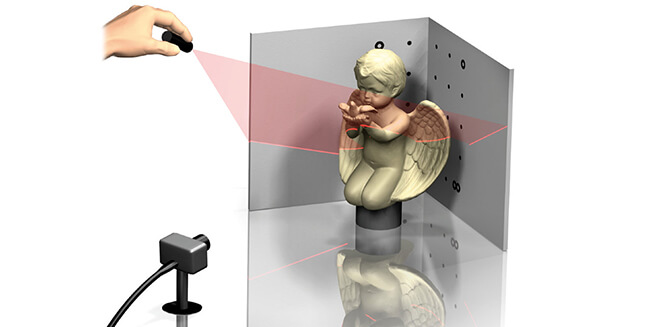3D Scanning Peruses Fresh Markets in Healthcare, Security, and Gaming

1 Mar
2016
Global markets are going gaga over how cool manufacturing operations have become; all credits to 3D scanning and printing techniques available at hand. Well-aware of the diverse usability added to the reduced calculative procedures, adoptability rate continues to grow for this technology. Typically, its application has been constricted to digital reconstruction of objects for documentation, modification, sampling, and commercial re-production. However, face and body scanning for security concerns, bio-engineering tissues and organs, and re-creation of virtual avatars mark commercial level entries in the market.
In closed silhouette
Let’s revisit the 3D scanning market for its current structure and pipeline applications. Invariably, all applications choose from the standard set of available technologies. Individual scanning units as well as in-built scanners integrated into portable devices share the market fairly. These scanners extract geometric samples from the object that are later extrapolated for recreating digital replicas. Literally, there is no limit to what scale or size the object must range within for it to be scan-able. Got doubts? Well, drones are already on their way, up in the sky, scanning to recreate detailed 3D maps of the Earth, in a joint-venture by 3D Robotics, Autodesk, Sony. Apart from civil and geo-physical engineering concept, reverse engineering, quality inspection, prototyping, and bio-scanning has been at the core of 3D scanning market.
In reverse engineering, the complete evaluation has been limited to a matter of few minutes without any invasive procedures. Close quality inspection at each stage of production, continuously monitors component compatibility with initially formulated idea. Additionally, simulations run on these derived designs predict functionality errors, if any. The technology has redefined prototyping at exalted speed levels. It is as easy as scanning anything you want and then printing it out of a machine; well, it is exactly that! Virtual cloning of chosen face and body has snaked applications into creating animated avatars for gaming and security purposes. Moreover, the technique has helped shape faces for unclaimed as well as ancient remains.
Imaging possibilities
Add digitalization to any concept, and what follows is a smart system. Similarly, three dimensional scanning is being led into future by the prospect of pro-active systems. For instance, self-driving cars and advanced space crafts are based on the concept of deciding course of action as per the ‘scanned surrounding’. Any detected obstruction is conveniently dealt by data intelligent robots. In medical contexts, patients derive benefits of reduced invasive procedures while adding value to time spent under clinical observation.
In a more relaxed environment, portable devices have begun integrating in-built scanners into their upcoming products. The target audience being children and tech-curious population. Hasbro, for example, filed a patent early in 2016, for kid-oriented 3D scanners. While, Intel demonstrated its RealSense 3-D camera for complete motion control of computers. On other notes, market players have ventured into providing open source tools for three dimensional scanning. This breaks through high costs that restrain general access of the technology to a huge population. 3Digify, introduces a similar concept with its Kickstarter campaign.
Market impressions
A dig at the current structure reveals mature and developing segments of the market. A structural analysis of 3D scanning market on basis of these segments predict stable overall growth projections. High costs continue to be the primary restraint for increase in rate of adoption. Cost competitive scanners brought to consumer platform in due course shall expand demand from regional markets. While improvements in resolution and range shall continue driving future applications.
In a report “World 3D Scanning Market Opportunities and Forecasts, 2014 – 2021”, published recently by Allied Market Research it has been pointed out that companies equipped with 3D scanners have an edge over their competitors. The report scans the market structure on the basis of type, range, service and application as well as the regional markets across various geographies. It takes into account the recent trends to indicate investment opportunities and helps stakeholders realize their role in the value chain analysis.

Akhilesh Prabhugaonkar
Author's Bio- Akhilesh Prabhugaonkar holds a bachelor’s degree in Electronics Engineering from the reputed Vishwakarma Institute of Technology. He has a special interest in the fields of forensics, world history, international relations and foreign policy, sports, agriculture, astronomy, security, and oceanography. An ardent bibliophile and melophile, Akhilesh loves to write on topics of his interest and various other societal issues. This love for writing made him enter the professional world of content writing and pursue his career in this direction.
Avenue: Entire Library membership of Allied Market Research Reports at your disposal
- Avenue is an innovative subscription-based online report database.
- Avail an online access to the entire library of syndicated reports on more than 2,000 niche industries and company profiles on more than 12,000 firms across 11 domains.
- A cost-effective model tailored for entrepreneurs, investors, and students & researchers at universities.
- Request customizations, suggest new reports, and avail analyst support as per your requirements.
- Get an access to the library of reports at any time from any device and anywhere.
Related Post
-
How Does Cable Tray Act as a Robust and Sustainable Solution for Various Leading Industries?
-
Performance Bank Guarantee: How Digitalization Is a Profitable Option for Your Business?
-
Stroke Management: How Gene Therapy and Smart Wearables Streamline the Treatment Process?
-
Which Cutting-Edge CNC Machines Are Transforming the Manufacturing Businesses Globally?
-
Luxury Car Rental: How Technological Advancements Can Boost Profitability of Your Fleet Business?
-
Why are Food Processing Businesses Increasingly Shifting Towards Halal Food Products?
-
Which Heat Sink Industry Trends Your Semiconductor Business Be Aware of?








